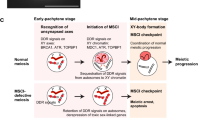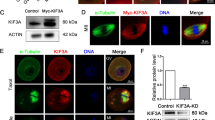Abstract
Faithful chromosome segregation requires correct attachment of kinetochores with the spindle microtubules. Erroneously-attached kinetochores recruit proteins to activate Spindle assembly checkpoint (SAC), which senses the errors and signals cells to delay anaphase progression for error correction. Temporal control of the levels of SAC activating-proteins is critical for checkpoint activation and silencing, but its mechanism is not fully understood. Here, we show that E3 ubiquitin ligase, SCF-FBXW7 targets BubR1 for ubiquitin-mediated degradation and thereby controls SAC in human cells. Depletion of FBXW7 results in prolonged metaphase arrest with increased stabilization of BubR1 at kinetochores. Similar kinetochore stabilization is also observed for BubR1-interacting protein, CENP-E. FBXW7 induced ubiquitination of both BubR1 and the BubR1-interacting kinetochore-targeting domain of CENP-E, but CENP-E domain degradation is dependent on BubR1. Interestingly, Cdk1 inhibition disrupts FBXW7-mediated BubR1 targeting and further, phospho-resistant mutation of Cdk1-targeted phosphorylation site, Thr 620 impairs BubR1-FBXW7 interaction and FBXW7-mediated BubR1 ubiquitination, supporting its role as a phosphodegron for FBXW7. The results demonstrate SCF-FBXW7 as a key regulator of spindle assembly checkpoint that controls stability of BubR1 and its associated CENP-E at kinetochores. They also support that upstream Cdk1 specific BubR1 phosphorylation signals the ligase to activate the process.







Similar content being viewed by others
Data availability statement
All relevant data are available.
References
Holland AJ, Cleveland DW (2009) Boveri revisited: chromosomal instability, aneuploidy and tumorigenesis. Nat Rev Mol Cell Biol 10:478–487. https://doi.org/10.1038/nrm2718
Ricke RM, Van Ree JH, Van Deursen JM (2008) Whole chromosome instability and cancer: a complex relationship. Trends Genet 24:457–466. https://doi.org/10.1016/j.tig.2008.07.002
Schvartzman JM, Sotillo R, Benezra R (2010) Mitotic chromosomal instability and cancer: mouse modelling of the human disease. Nat Rev Cancer 10:102–115. https://doi.org/10.1038/nrc2781
Daniel P, Cahill CL, Jian Yu, Riggins GJ, Willson JKV, Markowitz SD, Kinzler KW, Vogelstein B (1998) Mutations of mitotic checkpoint genes in human cancers. Nature 392:300–303. https://doi.org/10.1038/32688
Masuda A, Takahashi T (2002) Chromosome instability in human lung cancers: possible underlying mechanisms and potential consequences in the pathogenesis. Oncogene 21:6884–6897. https://doi.org/10.1038/sj.onc.1205566
Nezi L, Musacchio A (2009) Sister chromatid tension and the spindle assembly checkpoint. Curr Opin Cell Biol 21:785–795. https://doi.org/10.1016/j.ceb.2009.09.007
Shepperd LA, Meadows JC, Sochaj AM et al (2012) Phosphodependent recruitment of Bub1 and Bub3 to Spc7/KNL1 by Mph1 kinase maintains the spindle checkpoint. Curr Biol 22:891–899. https://doi.org/10.1016/j.cub.2012.03.051
Lara-Gonzalez P, Pines J, Desai A (2021) Spindle assembly checkpoint activation and silencing at kinetochores. Semin Cell Dev Biol 117:86–98. https://doi.org/10.1016/j.semcdb.2021.06.009
Liu ST, Zhang H (2016) The mitotic checkpoint complex (MCC): looking back and forth after 15 years AIMS. Mol Sci 3:597–634. https://doi.org/10.3934/molsci.2016.4.597
Zhang G, Kruse T, Lopez-Mendez B et al (2017) Bub1 positions Mad1 close to KNL1 MELT repeats to promote checkpoint signalling. Nat Commun 8:15822. https://doi.org/10.1038/ncomms15822
Piano V, Alex A, Stege P et al (2021) CDC20 assists its catalytic incorporation in the mitotic checkpoint complex. Science 371:67–71. https://doi.org/10.1126/science.abc1152
Lischetti T, Nilsson J (2015) Regulation of mitotic progression by the spindle assembly checkpoint Mol. Cell Oncol 2:e970484. https://doi.org/10.4161/23723548.2014.970484
Craske B, Welburn JPI (2020) Leaving no-one behind: how CENP-E facilitates chromosome alignment. Essays Biochem 64:313–324. https://doi.org/10.1042/EBC20190073
Schaar BT, Chan GKT, Maddox P, Salmon ED, Yen TJ (1997) CENP-E function at kinetochores is essential for chromosome alignment. JCB 139:1373–1382
Yen TJ, Li G, Schaar BT et al (1992) CENP-E is a putative kinetochore motor that accumulates just before mitosis. Nature 359:536–539. https://doi.org/10.1038/359536a0
Brown KD, Coulson RM, Yen TJ et al (1994) Cyclin-like accumulation and loss of the putative kinetochore motor CENP-E results from coupling continuous synthesis with specific degradation at the end of mitosis. J Cell Biol 125:1303–1312. https://doi.org/10.1083/jcb.125.6.1303
Magidson V, Paul R, Yang N et al (2015) Adaptive changes in the kinetochore architecture facilitate proper spindle assembly. Nat Cell Biol 17:1134–1144. https://doi.org/10.1038/ncb3223
Wu M, Chang Y, Hu H et al (2019) LUBAC controls chromosome alignment by targeting CENP-E to attached kinetochores. Nat Commun 10:273. https://doi.org/10.1038/s41467-018-08043-7
Ciossani G, Overlack K, Petrovic A et al (2018) The kinetochore proteins CENP-E and CENP-F directly and specifically interact with distinct BUB mitotic checkpoint Ser/Thr kinases. J Biol Chem 293:10084–10101. https://doi.org/10.1074/jbc.RA118.003154
Chan GK, Schaar BT, Yen TJ (1998) Characterization of the kinetochore binding domain of CENP-E reveals interactions with the kinetochore proteins CENP-F and hBUBR1. J Cell Biol 143:49–63. https://doi.org/10.1083/jcb.143.1.49
Grabsch H, Takeno S, Parsons WJ et al (2003) Overexpression of the mitotic checkpoint genes BUB1, BUBR1, and BUB3 in gastric cancer–association with tumour cell proliferation. J Pathol 200:16–22. https://doi.org/10.1002/path.1324
Yamamoto Y, Matsuyama H, Chochi Y et al (2007) Overexpression of BUBR1 is associated with chromosomal instability in bladder cancer. Cancer Genet Cytogenet 174:42–47. https://doi.org/10.1016/j.cancergencyto.2006.11.012
Kops GJ, Foltz DR, Cleveland DW (2004) Lethality to human cancer cells through massive chromosome loss by inhibition of the mitotic checkpoint. Proc Natl Acad Sci U S A 101:8699–8704. https://doi.org/10.1073/pnas.0401142101
Lampson MA, Renduchitala K, Khodjakov A et al (2004) Correcting improper chromosome-spindle attachments during cell division. Nat Cell Biol 6:232–237. https://doi.org/10.1038/ncb1102
Elowe S (2011) Bub1 and BubR1: at the interface between chromosome attachment and the spindle checkpoint. Mol Cell Biol 31:3085–3093. https://doi.org/10.1128/MCB.05326-11
Johnson VL, Scott MI, Holt SV et al (2004) Bub1 is required for kinetochore localization of BubR1, Cenp-E, Cenp-F and Mad2, and chromosome congression. J Cell Sci 117:1577–1589. https://doi.org/10.1242/jcs.01006
Elowe S, Hummer S, Uldschmid A et al (2007) Tension-sensitive Plk1 phosphorylation on BubR1 regulates the stability of kinetochore microtubule interactions. Genes Dev 21:2205–2219. https://doi.org/10.1101/gad.436007
Suijkerbuijk SJ, Vleugel M, Teixeira A et al (2012) Integration of kinase and phosphatase activities by BUBR1 ensures formation of stable kinetochore-microtubule attachments. Dev Cell 23:745–755. https://doi.org/10.1016/j.devcel.2012.09.005
Kaisari S, Miniowitz-Shemtov S, Sitry-Shevah D et al (2022) Role of ubiquitin-protein ligase UBR5 in the disassembly of mitotic checkpoint complexes. Proc Natl Acad Sci U S A. https://doi.org/10.1073/pnas.2121478119
Deshaies RJ, Joazeiro CA (2009) RING domain E3 ubiquitin ligases. Annu Rev Biochem 78:399–434. https://doi.org/10.1146/annurev.biochem.78.101807.093809
Lee EK, Diehl JA (2014) SCFs in the new millennium. Oncogene 33:2011–2018. https://doi.org/10.1038/onc.2013.144
Skaar JR, Pagan JK, Pagano M (2013) Mechanisms and function of substrate recruitment by F-box proteins. Nat Rev Mol Cell Biol 14:369–381. https://doi.org/10.1038/nrm3582
Stephenson SEM, Costain G, Blok LER et al (2022) Germline variants in tumor suppressor FBXW7 lead to impaired ubiquitination and a neurodevelopmental syndrome. Am J Hum Genet 109:601–617
Davis RJ, Welcker M, Clurman BE (2014) Tumor suppression by the Fbw7 ubiquitin ligase: mechanisms and opportunities. Cancer Cell 26:455–464. https://doi.org/10.1016/j.ccell.2014.09.013
Grim JE, Gustafson MP, Hirata RK et al (2008) Isoform- and cell cycle-dependent substrate degradation by the Fbw7 ubiquitin ligase. J Cell Biol 181:913–920. https://doi.org/10.1083/jcb.200802076
Malyukova A, Dohda T, Von Der Lehr N et al (2007) The tumor suppressor gene hCDC4 is frequently mutated in human T-cell acute lymphoblastic leukemia with functional consequences for Notch signalling. Cancer Res 67:5611–5616. https://doi.org/10.1158/0008-5472.CAN-06-4381
Maser RS, Choudhury B, Campbell PJ et al (2007) Chromosomally unstable mouse tumours have genomic alterations similar to diverse human cancers. Nature 447:966–971. https://doi.org/10.1038/nature05886
O’neil J, Grim J, Strack P et al (2007) FBW7 mutations in leukemic cells mediate NOTCH pathway activation and resistance to gamma-secretase inhibitors. J Exp Med 204:1813–1824. https://doi.org/10.1084/jem.20070876
Welcker M, Orian A, Grim JE et al (2004) A nucleolar isoform of the Fbw7 ubiquitin ligase regulates c-Myc and cell size. Curr Biol 14:1852–1857. https://doi.org/10.1016/j.cub.2004.09.083
Fan J, Bellon M, Ju M et al (2022) Clinical significance of FBXW7 loss of function in human cancers. Mol Cancer 21:87. https://doi.org/10.1186/s12943-022-01548-2
Yeh CH, Bellon M, Nicot C (2018) FBXW7: a critical tumor suppressor of human cancers. Mol Cancer 17:115. https://doi.org/10.1186/s12943-018-0857-2
Rajagopalan H, Jallepalli PV, Rago C et al (2004) Inactivation of hCDC4 can cause chromosomal instability. Nature 428:77–81. https://doi.org/10.1038/nature02313
Badarudeen B, Gupta R, Nair SV et al (2020) The ubiquitin ligase FBXW7 targets the centriolar assembly protein HsSAS-6 for degradation and thereby regulates centriole duplication. J Biol Chem 295:4428–4437. https://doi.org/10.1074/jbc.AC119.012178
Legal T, Hayward D, Gluszek-Kustusz A et al (2020) The C-terminal helix of BubR1 is essential for CENP-E-dependent chromosome alignment. J Cell Sci. https://doi.org/10.1242/jcs.246025
Singh P, Pesenti ME, Maffini S et al (2021) BUB1 and CENP-U, primed by CDK1, are the main PLK1 kinetochore receptors in mitosis. Mol Cell 81(67–87):e69. https://doi.org/10.1016/j.molcel.2020.10.040
Lan H, Tan M, Zhang Q et al (2019) LSD1 destabilizes FBXW7 and abrogates FBXW7 functions independent of its demethylase activity. Proc Natl Acad Sci U S A 116:12311–12320. https://doi.org/10.1073/pnas.1902012116
Vassilev LT, Tovar C, Chen S et al (2006) Selective small-molecule inhibitor reveals critical mitotic functions of human CDK1. Proc Natl Acad Sci U S A 103:10660–10665. https://doi.org/10.1073/pnas.0600447103
Miniowitz-Shemtov S, Eytan E, Ganoth D et al (2012) Role of phosphorylation of Cdc20 in p31(comet)-stimulated disassembly of the mitotic checkpoint complex. Proc Natl Acad Sci U S A 109:8056–8060. https://doi.org/10.1073/pnas.1204081109
Itoh G, Ikeda M, Iemura K et al (2018) Lateral attachment of kinetochores to microtubules is enriched in prometaphase rosette and facilitates chromosome alignment and bi-orientation establishment. Sci Rep 8:3888. https://doi.org/10.1038/s41598-018-22164-5
Rodriguez-Rodriguez JA, Lewis C, Mckinley KL et al (2018) Distinct roles of RZZ and Bub1-KNL1 in mitotic checkpoint signaling and kinetochore expansion. Curr Biol 28(3422–3429):e3425. https://doi.org/10.1016/j.cub.2018.10.006
Pereira C, Reis RM, Gama JB et al (2018) Self-Assembly of the RZZ complex into filaments drives kinetochore expansion in the absence of microtubule attachment. Curr Biol 28(3408–3421):e3408. https://doi.org/10.1016/j.cub.2018.08.056
Sacristan C, Ahmad MUD, Keller J et al (2018) Dynamic kinetochore size regulation promotes microtubule capture and chromosome biorientation in mitosis. Nat Cell Biol 20:800–810. https://doi.org/10.1038/s41556-018-0130-3
Xu HZ, Wang ZQ, Shan HZ et al (2018) Overexpression of Fbxo6 inactivates spindle checkpoint by interacting with Mad2 and BubR1. Cell Cycle 17:2779–2789. https://doi.org/10.1080/15384101.2018.1557488
Huang Y, Yao Y, Xu HZ et al (2009) Defects in chromosome congression and mitotic progression in KIF18A-deficient cells are partly mediated through impaired functions of CENP-E. Cell Cycle 8:2643–2649. https://doi.org/10.4161/cc.8.16.9366
Acknowledgements
We thank Dr. Don Cleveland, UCSD for the CENP-E wild type plasmid and Dr. Julie Welburn, University of Edinburgh for the MBP-BubR1-408-778 and MBP-CENP-E-2055-2608 plasmids. We also thank Dr. Bruce E Clurman, Fred Hutchinson Cancer Research Center, U. S. A. for FBXW7 (alpha) plasmid. Financial support from DBT, Govt. of India, and DST-SERB, Govt. of India to TKM are thankfully acknowledged.
Funding
Department of Biotechnology, Ministry of Science and Technology, India.
Author information
Authors and Affiliations
Corresponding author
Ethics declarations
Conflict of interest
The authors declare no conflict of interest.
Additional information
Publisher's Note
Springer Nature remains neutral with regard to jurisdictional claims in published maps and institutional affiliations.
Supplementary Information
Below is the link to the electronic supplementary material.
Supplementary file2 (AVI 10888 KB)
Supplementary file3 (AVI 76805 KB)
Supplementary file4 (AVI 76805 KB)
Supplementary file5 (AVI 2919 KB)
Supplementary file6 (AVI 8704 KB)
Rights and permissions
Springer Nature or its licensor (e.g. a society or other partner) holds exclusive rights to this article under a publishing agreement with the author(s) or other rightsholder(s); author self-archiving of the accepted manuscript version of this article is solely governed by the terms of such publishing agreement and applicable law.
About this article
Cite this article
Nair, V.M., Sabu, A.S., Hussain, A. et al. E3-ubiquitin ligase, FBXW7 regulates mitotic progression by targeting BubR1 for ubiquitin-mediated degradation. Cell. Mol. Life Sci. 80, 374 (2023). https://doi.org/10.1007/s00018-023-05019-9
Received:
Revised:
Accepted:
Published:
DOI: https://doi.org/10.1007/s00018-023-05019-9




